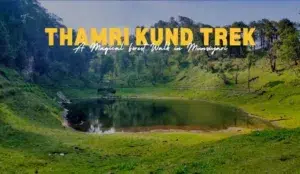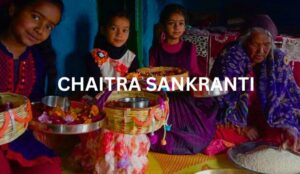Tsampa is a traditional Himalayan food made from roasted barley flour. It has been a staple in Ladakh, Tibet, and other Himalayan regions for centuries. This simple yet highly nutritious dish is not only a daily meal but also deeply woven into the cultural and spiritual practices of the Ladakhi people.
If you ever visit Ladakh, you will find it being enjoyed by monks in monasteries, nomads in the mountains, and locals in their homes. Its nutty, earthy flavor and ease of preparation make it a cherished food for people living in high-altitude conditions.
Tsampa’s Role in Ladakh
In Ladakh, where the climate is harsh and resources are limited, it has been an essential source of nutrition for generations. Barley, the main ingredient of Tsampa, is one of the few crops that can grow in Ladakh’s extreme weather. This makes it not just food but a symbol of survival and self-sufficiency.
The Ladakhi people consume it in different ways, often mixing it with butter tea (Gur Gur Cha), milk, or curd to make a nourishing meal. It is also an integral part of religious offerings in monasteries and cultural festivals.
What Makes Tsampa Special?
- Nutrient-Rich and Energy-Boosting: it is packed with fiber, protein, and essential minerals, making it an excellent energy source, especially in the cold climate of Ladakh.
- Easy to Prepare: Since the barley is roasted before being ground into flour, it requires no cooking—just mix and eat.
- Long Shelf Life: It can be stored for months, making it ideal for long treks, nomadic life, and monastery supplies.
- Sustainable and Locally Sourced: Grown in Ladakh’s high-altitude fields, it is an eco-friendly food supporting local farmers.
How is Tsampa made
Ingredients :
The traditional ingredients of Tsampa include:
- Roasted barley flour – the main ingredient
- Butter tea (Gur Gur Cha) – made with yak butter, tea leaves, and salt
- Milk or water – for softening the flour
- Yak butter – for extra richness
- Sugar or honey (optional) – for a slightly sweet taste
- Cheese or dry fruits (optional) – for added flavor and nutrition
Steps :
Making it is incredibly simple and requires no cooking. Here’s how:
1. Gather the Ingredients:
- 1 cup roasted barley flour
- ½ cup butter tea (or warm water/milk)
- 1 teaspoon sugar or honey (optional)
- 1 tablespoon yak butter (or regular butter)
2. Mix the Ingredients:
- Pour the butter tea (or warm liquid) into a bowl.
- Add the roasted barley flour little by little while stirring.
- Add butter and sugar/honey if desired.
3. Knead and Shape:
- Use your hands to mix everything into a soft dough.
- Shape it into small balls or eat it directly with a spoon.
Where Can You Enjoy Tsampa in Ladakh?
If you visit Ladakh, you can enjoy freshly prepared Tsampa in:
- Traditional Ladakhi homes – where families have been making and eating it for generations. It is often served as breakfast or a quick energy-boosting snack.
- Monasteries – Buddhist monks consume it as part of their simple yet nutritious diet, and it is also offered during religious ceremonies.
- Local tea houses and cafés in Leh, Hemis, and Diskit – these places serve it with butter tea, providing visitors with an authentic taste of Ladakhi culture.
- Markets in Leh – you can buy roasted barley flour from local vendors and prepare Tsampa at home just as the locals do.
Why You Should Try Tsampa
- A Unique Taste Experience – it’s nutty and earthy flavor is unlike any other dish, offering a simple yet fulfilling taste.
- Healthy and Nutritious – It provides long-lasting energy, making it ideal for travelers, trekkers, and those exploring Ladakh’s rugged terrain.
- A Cultural Connection – Eating it allows you to experience Ladakh’s deep-rooted traditions and the daily lifestyle of its people.
- Easy to Make – Even if you’re not in Ladakh, you can try making it at home with just a few ingredients and experience a part of Ladakhi cuisine.
Other Traditional Ladakhi Dishes to Try
Apart from Tsampa, Ladakh has many delicious and unique dishes worth trying:
Thukpa
Thukpa is a warm noodle soup with vegetables or meat, perfect for the cold weather.
Skyu
A traditional Ladakhi pasta dish made with wheat flour and cooked with root vegetables, often enjoyed in winter.
Momos
Steamed dumplings are filled with meat or vegetables and served with spicy chutney. They are a favorite among locals and tourists alike.
Chhurpi
A hard, dried cheese made from yak or cow’s milk, often eaten as a snack or added to soups for extra flavor.
Butter Tea (Gur Gur Cha)
It is a salty, buttery tea that keeps the body warm and is an essential part of Ladakhi hospitality.
Chhang
A local barley-based alcoholic drink, often brewed at home and enjoyed during festivals and social gatherings.
Conclusion
it is more than just food—it is a cultural treasure of Ladakh. Whether you are an adventurous traveler, a foodie, or simply someone looking for a healthy and authentic Himalayan dish, it is a must-try! It connects you to the traditions, flavors, and lifestyle of the Ladakhi people in the most delicious way possible. So, if you ever find yourself in Ladakh, don’t miss the chance to experience this ancient, wholesome superfood.
FAQs About Tsampa
1. Is Tsampa gluten-free?
No, since it is made from barley, it contains gluten and is not suitable for people with gluten intolerance.
2. Can I buy Tsampa outside Ladakh?
Yes, some specialty stores and online retailers sell roasted barley flour, allowing you to make it at home.
3. What does Tsampa taste like?
It has a slightly nutty, roasted, and earthy flavor. When mixed with butter tea, it becomes creamy and rich.
4. Can Tsampa be eaten in different ways?
Yes! Some people eat it dry like a snack, while others mix it with butter tea, milk, or even yogurt.
5. Is Tsampa good for trekking?
Absolutely! It is lightweight, easy to carry, and provides long-lasting energy, making it perfect for trekking and high-altitude travel.
6. Is Tsampa vegetarian?
Yes, it itself is vegetarian. However, the way it is prepared (with butter tea, or dairy) can vary.





